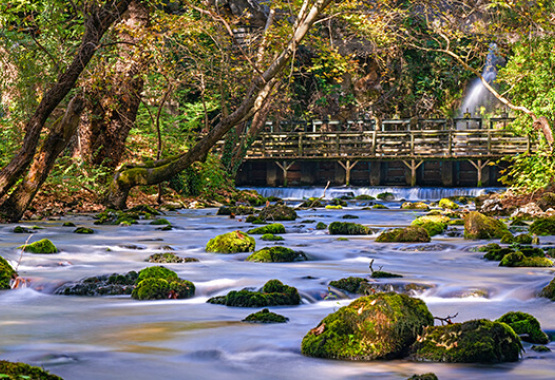
MONEMVASIA
3 millenia was the period required by nature in order to create these unique cave formations, having shaped figures and stone complexes of an exceptional variety. Among the huge red and white-coloured stone cascades, the gigantic multi-shaped columns, the curtains and sheets of rock hanging from the roof and resembling wax figures, you will see formations which look like coloured octopuses, corals, medusas, little elephants, mushrooms, birds, other funny shapes, exotic plants and other large rock structures.
Next, you enter the Chamber of Mushrooms, a vast room adorned with stalagmites shaped like mushrooms. Walk through them and descend the Royal Stairway, decked with cactus-shaped stalagmites. Their elegance and stratification led to the creation of a so-called exotic garden. Straight on, you will enter the Chamber of Fir Trees, whose gigantic stalagmites are truly awesome. You can visit the Chamber of Candles, going up another flight of stairs. Shaped like Paschal Candles, the alabaster stalagmites have formed two structures. Follow the winding course through them and descend the Stairway of the Water lilies which leads back to the Chamber of Fir Trees and then to the Chocolate Chamber which was named after a pillar that looks like a bar of chocolate, at its centre. To the left of this pillar, through an opening, feast your eyes on the Alabaster Chamber whose snow-white and transparent decoration is in sharp contrast with the former chamber in terms of colour and quality.
Just before you complete your visit, you will reach a Large Balcony. Above this lies the Apartment of the Bushes. Follow the spiral corridor through them and you will enjoy a fine view of all the chambers you’ve visited, from the top.
And if you feel like eating something, why not try some of the local delicacies served in the cosy café, by the cave!
Kastania Cave
Attuning your senses to the Cave!
Kastania’s Cave (or St Andrew’s Cave named after the nearby small church) lies in Peloponnese's south tip, unseen at the foot of Mt. Parnonas’ east mountainside, at a short distance from Neapoli and Monemvasia in Laconia. The wide diversity of rock shapes, colours and forms have made it the cave number two of its kind across Europe! It covers an area of 1,500 m2, shaped in two levels and the visitable part is 500 m. long.3 millenia was the period required by nature in order to create these unique cave formations, having shaped figures and stone complexes of an exceptional variety. Among the huge red and white-coloured stone cascades, the gigantic multi-shaped columns, the curtains and sheets of rock hanging from the roof and resembling wax figures, you will see formations which look like coloured octopuses, corals, medusas, little elephants, mushrooms, birds, other funny shapes, exotic plants and other large rock structures.
A tour in Kastania’s Cave
A spiral corridor will lead you down to the First Chamber which is decked with stalagmites in various shapes as well as columns. To the left, lies the Red Chamber following a downward direction. On the right you will see a series of beautiful pillars separating this chamber from the Water Chamber, a large and impressive room with a small pond inside it, after which it was named. This pond actually led to the discovery of the cave. On your right there is a row of enormous stalagmites on a higher level, resembling a large balcony, which separate the Water Chamber from the ‘Apartments of the Bushes’. Next to the stalagmites you will see huge pillars which look like Giants.Next, you enter the Chamber of Mushrooms, a vast room adorned with stalagmites shaped like mushrooms. Walk through them and descend the Royal Stairway, decked with cactus-shaped stalagmites. Their elegance and stratification led to the creation of a so-called exotic garden. Straight on, you will enter the Chamber of Fir Trees, whose gigantic stalagmites are truly awesome. You can visit the Chamber of Candles, going up another flight of stairs. Shaped like Paschal Candles, the alabaster stalagmites have formed two structures. Follow the winding course through them and descend the Stairway of the Water lilies which leads back to the Chamber of Fir Trees and then to the Chocolate Chamber which was named after a pillar that looks like a bar of chocolate, at its centre. To the left of this pillar, through an opening, feast your eyes on the Alabaster Chamber whose snow-white and transparent decoration is in sharp contrast with the former chamber in terms of colour and quality.
Just before you complete your visit, you will reach a Large Balcony. Above this lies the Apartment of the Bushes. Follow the spiral corridor through them and you will enjoy a fine view of all the chambers you’ve visited, from the top.
Nature’s vivid imagination
The cave formations are made of calcium carbonate in the shape of crystals enriched with metal oxides from the subsoil, creating a seven colour palette. Notice the remarkable and rare discs, flat stalagmites, eccentric stalactites, and helictites. With a little luck you will meet a cave resident, the blind and deaf dolichopoda which is a type of transparent spider with long antennae.How to get there
The cave is located near Kato Kastania village, approx. 17 km. E of Neapoli. The route from Neapoli is an experience that will be etched in your memory: images of green mountainsides facing Epidilion and Cape Kamila, picturesque villages where you can hear the gurgling sound of nearby spring waters, Byzantine churches, mediaeval castles, ravines with old watermills, archaeological finds and the infinite blue of the Myrtoo Sea!And if you feel like eating something, why not try some of the local delicacies served in the cosy café, by the cave!




